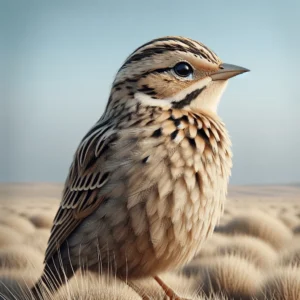The tiny but fascinating Fischer’s Sparrow-Lark (Eremopterix leucopareia) is a species of bird that lives best in the semi-arid and arid regions of Eastern Africa.
This bird has attracted the attention of both conservationists and birdwatchers due to its unusual appearance and fascinating habits.
This comprehensive guide delves into the habitat, behavior, and conservation status of Fischer’s Sparrow-Lark, providing insights into why preserving this species is essential for biodiversity.

Understanding the Habitat and Distribution of the Sparrow-Lark
The Unique Ecosystems of Fischer’s Sparrow-Lark
Grasslands, semi-desert areas, and savannas are among the open, dry habitats they favor.
Its distribution spans from Ethiopia through Kenya, Tanzania, and Somalia, showcasing the bird’s adaptation to diverse yet challenging environments.
For those intrigued by the adaptive strategies of birds, our deep dive into the survival techniques of Galapagos Finches offers a compelling read.
Physical Characteristics
This bird species exhibits sexual dimorphism: males have a striking black and white plumage during breeding seasons, making them easily identifiable, while females and non-breeding males have more subdued colors.
Their small size helps them to be agile and able to search for food on the ground.
Understanding the social behavior of birds can be fascinating; learn more in our exploration of Chickadee’s complex social structures.
Vocalizations and Communication
Despite their diminutive stature, they are well-known for their melodic calls and songs, which are particularly important for social interactions and territorial defense during the mating season.
Adaptations to Semi-Arid Conditions
Fischer’s Sparrow Bird’s remarkable adaptations enable it to flourish in its challenging environments. From their feeding habits to breeding behaviors, these birds have developed unique strategies to survive in areas with scarce water and vegetation.
Behavior and Ecology
Feeding Habits and Diet
Primarily ground feeders, Fischer’s Sparrow Birds have a diet that includes seeds and insects. Their feeding behavior reflects their adaptation to the availability of resources in their environment, changing seasonally based on rainfall and plant growth.
Breeding Patterns and Nesting
The breeding season of Fischer’s Sparrow Bird is closely tied to the rainy season, indicating the importance of timing in their reproductive success.
Their nesting habits, including the construction of nests on the ground, highlight their adaptation to life in open terrain.
Where Does Fischer’s Sparrow-Lark Thrive?
Fischer’s Sparrow Bird (Eremopterix leucopareia) predominantly inhabits the savannas and semi-arid landscapes across Eastern Africa.
This bird prefers open territories where grasslands meet sparse woodlands, adapting remarkably well to its environment.
Fischer’s Sparrow-Lark
Conservation Status: The Need for Action
Threats Facing
Despite their wide distribution, Fischer’s Sparrow-Larks face threats from habitat degradation, climate change, and human activities. These pressures underscore the need for targeted conservation efforts to ensure their survival.
Efforts to Protect the Sparrow-Lark
Conservation initiatives for Fischer’s Sparrow-Lark include habitat preservation, research on population trends, and raising awareness about the species. Here is a detail of another lark, known as the Black-eared Sparrow-Lark.
Collaborative efforts between governments, NGOs, and local communities are vital to protecting these birds and their habitats.
Fischer’s Sparrow-Lark and Biodiversity
Fischer’s Sparrow-Lark plays a crucial role in their ecosystem, contributing to insect control and seed dispersal.
Their interaction with the environment and other species highlights the interconnectedness of ecosystems and the importance of each species within them.
Preserving Fischer’s Sparrow-Lark is essential for maintaining biodiversity and ecological balance. Visit the Species of Madagascar.
Conclusion
Fischer’s Sparrow-Lark serves as a remarkable example of nature’s resilience and adaptability. These birds, with their unique ecological niches and behaviors, contribute significantly to the biodiversity of the semi-arid and arid landscapes of Eastern Africa.
However, they face increasing threats from habitat loss, climate change, and human encroachment, which pose significant challenges to their survival.
FAQs
What makes Fischer’s Sparrow-Lark unique?
They stand out for their distinctive plumage, with males showcasing a striking black-and-white pattern during the breeding season.
Their ability to survive in arid environments also sets them apart from other bird species.
How can I spot a Fischer’s Sparrow-Lark?
Look for these birds in open, dry areas where they feed on the ground or sing from low perches.
Males are especially visible during the breeding season, thanks to their contrasting black and white plumage.
What can I do to help conserve Fischer’s Sparrow-Lark?
Supporting habitat conservation initiatives and participating in citizen science projects to monitor bird populations are effective ways to contribute to the conservation of Fischer’s Sparrow Bird.
Educating others about the importance of biodiversity and the threats these birds face is also crucial.
What do Fischer’s Sparrow-Larks eat?
Primarily, they feed on seeds and small insects, foraging on the ground in their natural habitats.
How can I identify a Fischer’s Sparrow Bird?
Look for the distinctive black and white plumage in males during the breeding season, and listen for their unique songs and calls.
Is Fischer’s Sparrow Bird endangered?
While not currently listed as endangered, they face threats from habitat loss and climate change, highlighting the importance of conservation efforts.

